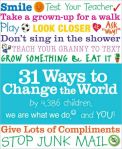This is one of those activism books for kids, aged 9- 12. I like it a bit more than the other 'how to' activism for kids books out there because it isn't telling kids to fight the world's evils, it isn't telling them that the world is going to end unless they do this, and it isn't at all large-scale. Many of the suggestions in this book only immediately effect the person who is doing them and the person/ people they're interacting with. Instead of listing all of the actions I'm just going to summarize the gist of them by category.
There are a few actions that suggest how to interact with people more, like your parents or your grandmother. In general, many of the actions tell the reader to do more things with people. This is an important suggestion with the rise of technology. Kids are spending more and more of their free time alone in front of some electronic device or another, and while this is fun for them for the moment, too much of this behaviour can alienate them from their friends and family.
So in addition to the do things with people group of actions, there are the 'do things' actions. Things like playing or writing a letter, grow something and eat it, these help get kids off the couch.
Then of course there are the environmentally aware actions, but it goes about presenting this in a kid friendly way. One of these is to love your stuff, it doesn't say this, but by loving your stuff you won't rush out to buy new stuff and you'll value what you have. There are also the standard 'don't waste power' actions, but they give you some real life examples like shower time and junk mail.
There are also the 'educate yourself' actions. These suggest that you learn another language or learn about a cause to support or to bug your parents about. One of the actions is to simply ask why, which is always a good tool for learning.
Overall I think that this is one of the better elementary school aged activist books I've come across. It's short and sweet but has a lot of valuable things to say. It's also very colourful and full of pictures so is easy on the eye. What I like about this book the most is that it doesn't only talk about how to fix your environment or how to make a political or social change, it also talks about how you should make more time for the people you see everyday. How you should be more active and more social, because believe it or not those tiny and 'insignificant' interactions are what will shape your world the most and are what will determine your happiness. And if more people are happy, the world will indeed change for the better.

No comments:
Post a Comment